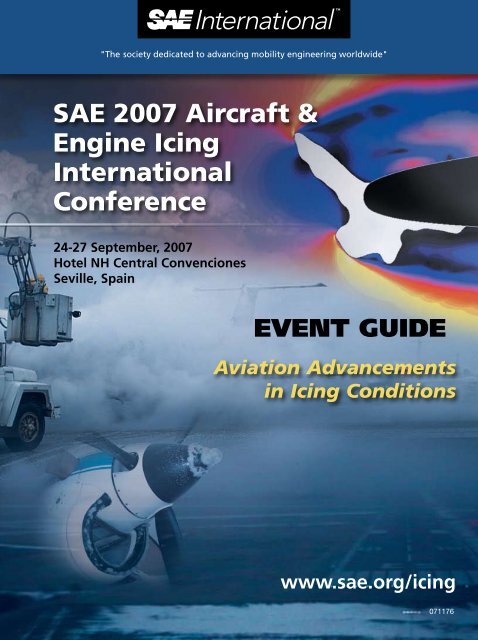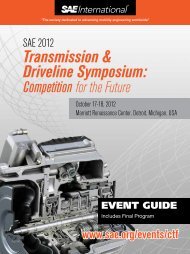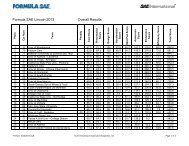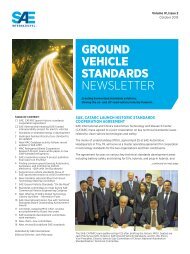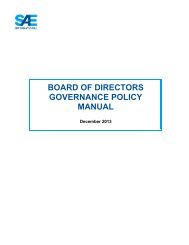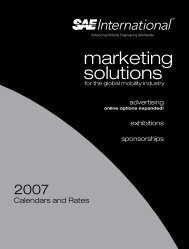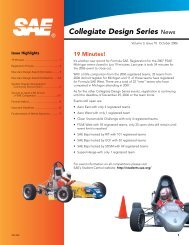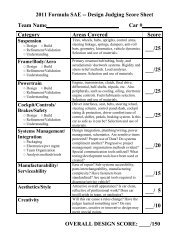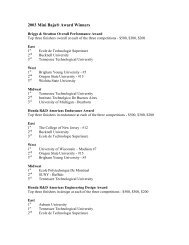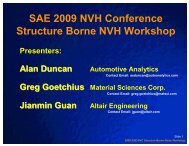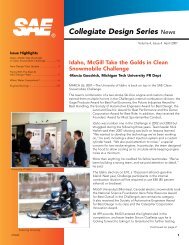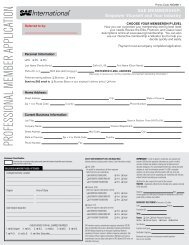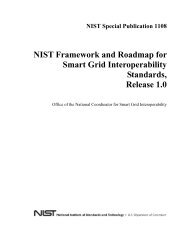Pages 1-22 - SAE International
Pages 1-22 - SAE International
Pages 1-22 - SAE International
Create successful ePaper yourself
Turn your PDF publications into a flip-book with our unique Google optimized e-Paper software.
<strong>SAE</strong> 2007 Aircraft &<br />
Engine Icing<br />
<strong>International</strong><br />
Conference<br />
24-27 September, 2007<br />
Hotel NH Central Convenciones<br />
Seville, Spain<br />
EVENT GUIDE<br />
Aviation Advancements<br />
in Icing Conditions<br />
www.sae.org/icing<br />
071176
WELCOME<br />
Welcome to the<br />
The 2007 <strong>SAE</strong> <strong>International</strong><br />
Aircraft and Engine icing Conference<br />
Dear Colleagues:<br />
Thomas H. Bond<br />
Eric Duvivier<br />
On behalf of <strong>SAE</strong> <strong>International</strong> and the Aircraft and Engine Icing<br />
Planning Committee, welcome to the 2007 <strong>SAE</strong> Aircraft and Engine<br />
Icing Conference. This conference will provide you with a special<br />
opportunity to interact with professionals knowledgeable in all areas of<br />
safe aircraft operations.<br />
Advancements in technology over the past few years demand a<br />
continuing need for information sharing. This conference provides<br />
a unique forum for showcasing the progress that has been made<br />
in research, simulation, regulatory, safety and industry standards<br />
development related to aircraft and engine icing, deicing, detection<br />
and protection.<br />
Over eighty of the industry’s brightest professionals from around the<br />
world have contributed to the development of the technical program.<br />
This is a chance to share your views regarding aircraft deicing<br />
fluids, environmental considerations, simulation CFD, in-flight icing,<br />
rotorcraft icing, aircraft engine icing, icing physics, meteorology, and<br />
certification. It is our wish that you will enjoy both the scope and depth<br />
of these presentations.<br />
As you spend the week in the beautiful city of Seville, we are certain<br />
your time will be filled with stimulating conversation, the exchange<br />
of innovative ideas and the building of greater friendships with<br />
professionals from around the world. In addition, we hope you will find<br />
a few moments to enjoy the many one-of-a-kind attractions found<br />
only in Seville.<br />
Thank you for your continued support and participation in the 2007<br />
<strong>SAE</strong> Aircraft and Engine Icing Conference.<br />
Thomas H. Bond<br />
2007 Conference General Co-Chair<br />
Chief Scientist and Technical Advisor,<br />
Flight Environmental Icing, AIR-103<br />
Federal Aviation Administration<br />
Eric Duvivier<br />
2007 Conference General Co-Chair<br />
Certification Directorate<br />
Cabin Safety & ECS Systems Expert<br />
EASA - EUROPEAN AVIATION SAFETY AGENCY<br />
<strong>SAE</strong> 2007 Aircraft & Engine Icing <strong>International</strong> Conference
What’s inside<br />
General Committee 2-3<br />
General Overview 4<br />
General Information 5<br />
Special Events and<br />
Networking Opportunities 8-16<br />
Floorplan 18-19<br />
Technical, Business and<br />
Executive Sessions 20-38<br />
At-A-Glance<br />
Details<br />
Plenary 24<br />
Icing Certification 25-26<br />
Aircraft Ground Operations<br />
& Deicing 27-30<br />
In-flight Icing / Deicing 31-35<br />
Meteorology Meteorology 36-38<br />
Participant Index 39<br />
Committee, Task Force and<br />
Board Meetings 40<br />
www.sae.org/icing<br />
<strong>SAE</strong> 2007 Aircraft & Engine Icing<br />
<strong>International</strong> Conference
<strong>SAE</strong> Committee Meeting List<br />
<strong>SAE</strong> <strong>International</strong> Officers<br />
2007 <strong>SAE</strong> President<br />
Richard O. Schaum<br />
2006 <strong>SAE</strong> President<br />
Greg W. Henderson<br />
<strong>SAE</strong> Vice President Aerospace<br />
Ronald E. York, Ph.D<br />
<strong>SAE</strong> Vice President Automotive<br />
Jacqueline A. Dedo<br />
<strong>SAE</strong> Vice President Commercial Vehicle<br />
Mark R. Pflederer<br />
<strong>SAE</strong> Treasurer<br />
Terence J. Rhoades<br />
<strong>SAE</strong> Assistant Treasurer<br />
Carol A. Story<br />
<strong>SAE</strong> Executive Vice President/COO<br />
& Secretary<br />
Raymond A. Morris<br />
Committee Information<br />
Conference Co-Chair<br />
Thomas H. Bond is the Chief Scientist and<br />
Technical Advisor for Flight Environmental Icing for<br />
the FAA. He took the position in late June 2007<br />
and will now support FAA aviation safety issues in<br />
aircraft icing.<br />
Prior to this, Tom was employed at the NASA<br />
Glenn (Lewis) Research Center, specializing in<br />
aircraft icing research. At NASA, he spent over 20<br />
years in aircraft icing research – the first 10 years<br />
doing experimental research on the NASA Twin<br />
Otter and in the Icing Research Tunnel. Mr. Bond<br />
became the Acting Branch Chief in 1997, with<br />
a permanent post in 1998. He guided the Icing<br />
Branch transition from a base R&T activity to<br />
include icing related aviation safety research. The<br />
scope of this work included research areas in iced<br />
Thomas H. Bond<br />
Chief Scientist and Technical Advisor,<br />
Flight Environmental Icing, AIR-103<br />
Federal Aviation Administration<br />
aerodynamics, iced flight dynamics, super-cooled large droplet engineering<br />
tools development, remote ice sensing/detection technologies and icing avoidance<br />
strategies, robust CFD simulations of ice accretion prediction, and icing<br />
education and training materials development for pilots and operators.<br />
<strong>SAE</strong> Aircraft & Engine Planning Committee<br />
Gene Addy, NASA John Glenn Research Center<br />
Kamel Al-Khalil, Cox and Co. Inc.<br />
Jack Allemann, <strong>International</strong> AG Basic<br />
Brian Anderson, Northwest Airlines<br />
Oliver Arzt, N ICE Aircraft Services and Support GmbH<br />
Cliff Barrow, UK Civil Aviation Authority<br />
Ben Bernstein, Leading Edge Atmospherics<br />
Colin Bidwell, NASA John Glenn Research Center<br />
Hans-Erik Bostrom, SAS Technical Services<br />
Michael Bragg, University of Illinois at Urbana<br />
Champaign<br />
Jean-Louis Brenguier, Metéo-France<br />
Shinan Chang, Beijing University of Aeronautics &<br />
Astronautics<br />
Lilian Clede, Goodrich Sensor Systems<br />
Stewart Cober, Environment Canada<br />
Jean-Edmond Coutris, Snecma<br />
Brock Crocker, Vestergaard Co. Inc.<br />
Kirsten Dyer, BAE Systems<br />
Alejandro Feo, Instituto Nacional de Tecnica<br />
Aeroespacial<br />
Cliff Fiscus, Federal Aviation Administration<br />
Robert Flemming, Sikorsky Aircraft Corp.<br />
Roger Gent, AeroTex UK<br />
Matthew Grzych, The Boeing Company<br />
Miguel Guerra, Instituto Nacional de Tecnica<br />
Aeroespacial<br />
Didier Guffond, ONERA<br />
Wagdi G. Habashi, McGill University<br />
Thomas Hauf, Universitat Hannover<br />
Eugene Hill, Boeing/Federal<br />
Aviation Administration (Retired)<br />
Doug Ingold, Transport Canada<br />
George Isaac, Environment Canada<br />
Kathi Ishimaru, Federal Aviation Administration<br />
David Johns, Transport Canada<br />
Christine LeBot, Metéo-France<br />
Jacques Leroux, Dow Chemical Canada Inc.<br />
Lyle Lilie, Science Engineering Associates<br />
<br />
<strong>SAE</strong> 2007 Aircraft & Engine Icing <strong>International</strong> Conference
Conference Co-Chair<br />
A graduate from Paris Aerospace Engineering School in 1998, Mr. Duvivier started<br />
in 1989 at French Ministry of Defence working as Environmental Control System<br />
(ECS) specialist on military programs. In 1991, he joined the airworthiness department<br />
of the French Direction de l’Aviation Civile in Paris, as ECS and Icing specialist,<br />
working certification and rule making issues. Since 1992, Mr. Duvivier has<br />
been highly involved for the Joint Aviation Authorities in certification programs<br />
and harmonisation of the JAR 25 with the FAR 25 icing and ECS related requirements.<br />
In that respect, he was a member of the Ice Protection Harmonisation<br />
Working Group (IPHWG) and Mechanical Systems HWG. In 1999, he was nominated<br />
by the JAA as Certification Standardisation Panel, acting in the JAA system,<br />
as co-ordinator and advisor for conflicting certification issues. Mr. Duvivier<br />
joined the European Aviation Safety Agency (EASA) as ECS and Icing expert in the<br />
Certification Directorate in September, 2004 and has since been nominated in the<br />
Panel of Experts of EASA to ensure that there is a consistent interpretation and<br />
application of requirements by EASA Teams following EASA Procedures<br />
Eric Duvivier<br />
Certification Directorate<br />
Cabin Safety & ECS Systems Expert<br />
EASA - EUROPEAN AVIATION<br />
SAFETY AGENCY<br />
John Lim, BAA PLC<br />
Robert Lunnon, UK Met<br />
Lasse Makkonen, VTT Technical<br />
Research Center of Finland<br />
Jeanne Mason, The Boeing Company<br />
Oliver McGregor, Qinetiq<br />
Laird McKinnon, Department of National Defence<br />
Leslie McVey, GE Aviation<br />
Richard Moser, AeroTex UK<br />
Barry Myers, Transport Canada<br />
John Oldenburg, NASA John Glenn Research Center<br />
David Parkins, American Kestrel Company<br />
Paul Pellicano, Federal Aviation Administration<br />
Michael Pigliacelli, Continental Airlines Inc.<br />
Mark Potapczuk, NASA John Glenn Research Center<br />
Alberto Pueyo, Bombardier<br />
Edward Pugacz, Federal Aviation Administration<br />
Decio Pullin, EMBRAER<br />
Thomas Ratvasky, NASA John Glenn Research Center<br />
James Riley, Federal Aviation Administration<br />
Alric Rothmayer, Iowa State University<br />
Charles Ryerson, US Army Corps of Engineers<br />
Saleem Sattar, Transport Canada<br />
Leslie Schultz, Civil Aviation Safety Authority<br />
Ian Sharkey, Radiant Aviation Services Inc.<br />
Jostein Skjefstad, Oslo Lufthavn AS<br />
George Soteropoulos, Federal Aviation Administration<br />
Walter Strapp, Environment Canada<br />
Krzysztof Szilder, National Research Council<br />
Kenji Togami, Mitsubishi Heavy Industries Ltd.<br />
Warren Underwood, Federal Aviation Administration<br />
Mario Vargas, NASA John Glenn Research Center<br />
Ludovico Vecchione, CIRA<br />
Kenneth Walper, Valcom Consulting Group Inc.<br />
Kathy Widing, MISCO Refractometer<br />
Wim Willemse, Saab AB<br />
Mary Wyderski, U.S. Air Force<br />
<strong>SAE</strong> 2007 Aircraft & Engine Icing <strong>International</strong> Conference
event overveiw<br />
Monday, 24<br />
September<br />
Tuesday, 25<br />
September<br />
Wednesday, 26<br />
September<br />
Thursday, 27<br />
September<br />
Friday, 28<br />
September<br />
09:00- 09:15<br />
Conference<br />
Introduction<br />
08:00 – 10:00<br />
Technical Sessions<br />
08:00 –10:00<br />
Technical Sessions<br />
08:00 – 10:00<br />
Technical Sessions<br />
Committee Meeting(s)<br />
/ Activities<br />
09:15 – 10:45<br />
Opening Plenary<br />
Theme 1: Updates<br />
on Accidents &<br />
Operational Events<br />
10:00 - 10:30<br />
Networking Break<br />
10:00 – 10:30<br />
Networking Break<br />
10:00 – 10:30<br />
Networking Break<br />
AC-9C<br />
Aircraft Environmental<br />
Systems Committee<br />
12:00-17:00<br />
10:45 – 11:15<br />
Networking Break<br />
10:30 – 12:30<br />
Technical Sessions<br />
10:30 – 12:30<br />
Technical Sessions<br />
10:30 – 12:30<br />
Technical Sessions<br />
11:15 – 13:00<br />
Opening Plenary<br />
Theme 2:<br />
Regulatory<br />
Perspectives on<br />
Icing<br />
13:00 – 14:00<br />
12:30 – 13:30<br />
Lunch<br />
Avenida Hall,<br />
Amistad Hall,<br />
Almería Hall<br />
12:30 – 13:30<br />
Lunch<br />
Avenida Hall,<br />
Amistad Hall,<br />
Almería Hall<br />
12:30 – 13:30<br />
Lunch<br />
Avenida Hall,<br />
Amistad Hall,<br />
Almería Hall<br />
Lunch<br />
Avenida Hall,<br />
Amistad Hall,<br />
Almería Hall<br />
13:30 – 15:30<br />
Technical Sessions<br />
13:30 – 15:30<br />
Technical Sessions<br />
13:30 - 14 :30<br />
Technical Sessions<br />
14:00 – 16:00<br />
Technical Sessions<br />
15:30 – 16:00<br />
Networking Break<br />
15:30 – 16:00<br />
Networking Break<br />
14:30 – 14:45<br />
Networking Break<br />
16:00 – 16:30<br />
Networking Break<br />
16:30 – 18:30<br />
16:00 – 18:00<br />
Technical Sessions<br />
16:00 – 18:00<br />
Technical Sessions<br />
14:45 – 15:45<br />
Closing Plenary &<br />
Closing Remarks<br />
Technical Sessions<br />
18:30 – 19:30<br />
Networking<br />
Reception in<br />
Avenida Hall,<br />
Amistad Hall,<br />
Almería Hall<br />
18:00 – 19:00<br />
Networking<br />
Reception in<br />
Avenida Hall,<br />
Amistad Hall,<br />
Almería Hall<br />
<br />
<strong>SAE</strong> 2007 Aircraft & Engine Icing <strong>International</strong> Conference
general information<br />
Hours of Operation<br />
On-site Registration<br />
Malaga/Marbella Foyer<br />
Sunday, 23 September .............16:00 - 18:00<br />
Monday, 24 September ............08:00 - 18:30<br />
Tuesday, 25 September ............07:30 - 18:00<br />
Wednesday, 26 September ......07:30 - 17:00<br />
Thursday, 27 September ..........07:30 - 15:00<br />
On-site Registration Fees<br />
<strong>SAE</strong> Member $695<br />
Non-Member* $895<br />
Participant<br />
(includes Organizer, Chair,<br />
author, presenter)<br />
$395<br />
Student** $25<br />
Media**<br />
Exhibitor***<br />
(limit 2 per booth)<br />
FREE<br />
FREE<br />
Unless otherwise mentioned, all prices are in US$<br />
* Includes one year of <strong>SAE</strong> membership, with a<br />
subscription to Aerospace Engineering magazine.<br />
** Does not include Conference Proceedings.<br />
***Two booth personnel included with exhibit<br />
booth; additional personnel at the member or<br />
non-member rate.<br />
Emergency Hotline<br />
1-800-581-9295<br />
<strong>SAE</strong> <strong>International</strong><br />
World Headquarters<br />
400 Commonwealth Drive<br />
Warrendale, PA 15096-0001 USA<br />
Phone: 1-724-776-4841<br />
Fax: 1-724-776-0790<br />
Customer Service<br />
1-877-606-7323 (toll free U.S.<br />
and Canada)<br />
1-724-776-4970<br />
www.sae.org<br />
customerservice@sae.org<br />
Automotive Headquarters<br />
755 W. Big Beaver Rd.<br />
Troy, MI 48084<br />
Phone: 1-248-273-2455<br />
Fax: 1-248-273-2494<br />
<strong>SAE</strong> 2007 Aircraft & Engine Icing <strong>International</strong> Conference
general information<br />
<strong>SAE</strong> Engineering Meetings<br />
Board<br />
Chairperson<br />
Debi L. Cohoon<br />
General Motors Corporation<br />
Past Chairperson<br />
Dr. David Cameron<br />
General Motors Corporation<br />
Networking Breaks<br />
Malaga/Marbella Foyer<br />
Monday, 24 September<br />
10:45 -11:15 and<br />
16:00-16:30<br />
Avenida Hall, Amistad Hall,<br />
Almería Hall<br />
Tuesday, 25 September and<br />
Wednesday, 26 September<br />
10:00-10:30 and<br />
15:30-16:00<br />
Malaga/Marbella Foyer<br />
Thursday, 27 September<br />
10:00-10:30 and<br />
14:30-14:45<br />
Liaison<br />
Dr. Ronald L. Williams, Retired<br />
Members<br />
Air and Space Group (ASG) Chair<br />
Dr Kamran Rokhsaz<br />
Wichita State Univ<br />
Continuing Professional Development<br />
Group (CPDG) Chair<br />
Alberto E. Funaioli<br />
Siemens VDO Automotive Corporation<br />
Luncheons<br />
Avenida Hall, Amistad Hall,<br />
Almería Hall<br />
Monday, 24 September<br />
13:00-14:00<br />
Avenida Hall, Amistad Hall,<br />
Almería Hall<br />
Tuesday, 25 September<br />
and<br />
Wednesday, 26 September<br />
12:30-13:30<br />
Avenida Hall, Amistad Hall,<br />
Almería Hall<br />
Thursday, 27 September<br />
12:30-13:30<br />
Land and Sea Group (LSG) Chair<br />
Wendy Clark<br />
National Renewable Energy Laboratory<br />
Members-at-Large<br />
Prof. Bernard J. Challen<br />
Shoreham Services<br />
Dr. Prakash T. Sathe<br />
Behr America Incorporated<br />
H. Robert (Bob) Welge<br />
Robert’s Engineering Development<br />
Receptions<br />
It is a great way to get acquainted with fellow attendees while relaxing<br />
over refreshments.<br />
Avenida Hall, Amistad Hall,<br />
Almería Hall<br />
Monday, 24 September<br />
18:30-19:30<br />
Avenida Hall, Amistad Hall,<br />
Almería Hall<br />
Tuesday, 25 September<br />
18:00-19:00<br />
Secretary<br />
Patti Kreh, <strong>SAE</strong> <strong>International</strong><br />
Things to Do and See in Seville<br />
Seville sits on the left bank of the<br />
Guadalquivir River and is located in<br />
Southwest Spain. It has approximately<br />
700,000 inhabitants, nearly half the<br />
population of the whole province.<br />
Its ancient history – which includes<br />
Roman and Islamic influence – has left<br />
its mark in the fascinating culture and<br />
architecture. In the 16th century, Seville<br />
(known as Sevilla in Spanish) became<br />
an important hub for travel and trade<br />
between Europe and the Americas.<br />
More recently, the city made headlines<br />
worldwide when it hosted the World<br />
Expo in 1992.<br />
Bullfighting, or corrida de toros, is<br />
something enjoyed or loathed by visitors<br />
and Spaniards alike. No matter your<br />
opinion, bullfighting is a tradition in<br />
Sevilla and the Plaza de Toros de la<br />
Maestranza is perhaps the best venue<br />
in all of Spain to watch the event. Even<br />
though the season is short, there are<br />
events taking place on September 29<br />
and 30. For more information, visit:<br />
www.exploreseville.com.<br />
Flamenco may have its birthplace in<br />
Seville, many argue this fact. The<br />
important thing to know is that the cradle<br />
of flamenco is in western Andalucia, and<br />
there are few better places to flamenco<br />
than Seville. Learn more by visiting:<br />
www.exploreseville.com.<br />
Parque Isla Magica amusement park<br />
is located on the original Expo92 site<br />
and is the only theme park in the world<br />
that is located right in the middle of<br />
the city. The amusement park, which<br />
opened in 1997, is centered around a<br />
<br />
<strong>SAE</strong> 2007 Aircraft & Engine Icing <strong>International</strong> Conference
On-site Services<br />
Business Center<br />
The business center is located in the hotel lobby and has one computer with 24 hour<br />
access. There is also one computer located in Restaurant Nhube which is available<br />
for use from 11:00 – midnight. To use either computer, instructions are posted with<br />
payment details. You can also purchase internet access vouchers in 15 minute<br />
increments.<br />
Message Center/Telephone Information<br />
Message board is located in the Registration Area.<br />
To leave messages, call: 0034 954 413 063. Mention you are calling for an attendee<br />
of the Aircraft & Engine Icing Conference. There is no paging system.<br />
Presentation Ready Room<br />
Available daily at 07:00-18:00 to review presentations.<br />
Located in the La Perdiz Room.<br />
Restaurants<br />
Please consult the hotel concierge or visit: www.exploreseville.com for suggestions/<br />
recommendations.<br />
lake and divided into seven themed areas<br />
representative of different episodes in<br />
Spanish 16th century history. For more<br />
information, visit: www.tripadvisor.com/<br />
travel-g187443-d539305/seville:spain:<br />
parque.isla.magica.html.<br />
Park of Maria Luisa is one of the city’s<br />
largest parks with a surface area greater<br />
than 400,000 meters. It was originally<br />
built as a Romantic garden for the palace<br />
of San Telmo on the occasion of the 1929<br />
Latin American Exhibition.<br />
Palacio de Lebrija is located on calle Cuna<br />
and is perhaps the largest collection of<br />
roman mosaics in Seville, besides any<br />
public museum. Venturing upstairs there<br />
is much more to the palace than just the<br />
mosaics.<br />
Plaza Espana was constructed for the<br />
1929 World’s Fair under the plans of<br />
architect Anibal Gonzalez, the Plaza de<br />
Espana is located on the edge of the<br />
Parque Maria Luisa.<br />
Santa Cruz is the old Jewish quarter or<br />
juderia located next to the Cathedral and<br />
the Alcazar. With narrow streets and<br />
plenty of plazas it’s a great place to relax<br />
for a drink or a stroll in the evening.<br />
There is so much to see and do in Sevilla,<br />
please visit the below listed websites for<br />
additional information on shopping, cultural<br />
activities, museums, cathedrals, nightlife,<br />
day trips, restaurants, etc.<br />
www.exploreseville.com<br />
www.sol.com/sevilla<br />
<strong>SAE</strong> 2007 Aircraft & Engine Icing <strong>International</strong> Conference
special events and networking opportunities<br />
MONDAY Conference Introduction –<br />
Almenara & Alanda Room<br />
Monday, 24 September<br />
09:00 – 09:15<br />
Thomas H. Bond Conference Co-Chair<br />
Chief Scientist and Technical Advisor,<br />
Flight Environmental Icing, AIR-103<br />
Federal Aviation Administration<br />
Eric Duvivier Conference Co-Chair<br />
Certification Directorate<br />
Cabin Safety & ECS Systems Expert<br />
EASA - EUROPEAN AVIATION SAFETY AGENCY<br />
Opening Plenary<br />
Almenara & Alanda Room<br />
Monday, 24 September<br />
09:15 – 10:45<br />
Malaga/Marbella Foyer<br />
Poster Session Details<br />
Please plan to visit the poster session located in the Malaga/Marbella Foyer throughout the week. Take<br />
advantage of this opportunity to speak one-on-one with colleagues highlighting accomplishments in<br />
research projects and vendors with new product developments. Posters on the following topics will be<br />
presented:<br />
“Meteorological Condition in Cases of Icing in the<br />
Low Parts of the Country”<br />
Dimitar Nikolov, Meteo<br />
“Simulation of Icing Events in the Czech Republic<br />
with MM5”<br />
Jiri Hosek, Institute of Atmospheric Physics, Prague,<br />
Academy of Sciences of the Czech Republic<br />
“COST Action 727 Supports Enabling the Full<br />
Potential of Wind Energy in Icing Climates”<br />
Göran PR Ronsten, WindREN, AB; Lasse Makkonen,<br />
VTT Technical Research Center of Finland; Bengt<br />
Tammelin, Finnish Meteorological Institute, FMI<br />
“Lewint a 2-D Ice Accretion Package”<br />
Dave Parkins, American Kestrel Company<br />
“Ultrasonic Shear Wave Anti-icing Actuator for<br />
Helicopter Blades”<br />
Jose Luis Palacios, Penn State University<br />
“Two - and Three Dimensional Ice Accretion<br />
Simulations”<br />
Serkan Ozgen, Middle East Technical University<br />
“Development Manufacture and Testing of De/<br />
Anti-icing Fluids to Prevent On-ground Icing of<br />
Airplanes”<br />
Serkan Ozgen, Middle East Technical University<br />
Poster Session Times:<br />
Monday, 24 September<br />
10:45 -11:15, 13:00-14:00 and 16:00-16:30<br />
Tuesday, 25 September<br />
10:00-10:30, 13:00-14:00 and 15:30-16:00<br />
Wednesday, 26 September<br />
10:00-10:30, 12:30-13:30 and 15:30-16:00<br />
Thursday, 27 September<br />
10:00-10:30, 12:30-13:30and 14:30-14:45<br />
<br />
<strong>SAE</strong> 2007 Aircraft & Engine Icing <strong>International</strong> Conference
Theme 1: Updates on Accidents & Operational Events<br />
MONDAY<br />
09:15 – 09:45<br />
Tony Cable<br />
Senior Inspector of Air Accidents<br />
Air Accidents Investigation Branch, UK<br />
Mr. Cable graduated from London University with a BSc Honours<br />
Degree in Aeronautical Engineering. He spent time with Boeing<br />
as a Powerplant Design Engineer on large public transport aircraft.<br />
He also served as a Systems and Safety Engineer with BAe, on<br />
the Tornado and Concorde. Mr. Cable has been a full-time Aircraft<br />
Accident Investigator with the UK Air Accidents Investigation Branch since 1976. He<br />
investigates the engineering aspects of accidents and incidents to civil and military<br />
aircraft and helicopters large and small. He holds private pilot’s licenses and flies fixed<br />
wing and rotary planes. He is an occasional lecturer and Visiting Fellow at Cranfield<br />
University, UK.<br />
“Accident to a Business Jet due to Frost – Investigation and Findings<br />
Summary”<br />
Opening Plenary<br />
Theme 1:<br />
Updates on Accidents &<br />
Operational Events<br />
09:15-09:45<br />
Tony Cable<br />
Air Accidents Investigation Branch,<br />
UK<br />
09:45 – 10:15<br />
Dan Bower<br />
National Transportation Safety Board<br />
10:15 – 10:45<br />
Jeanne G. Mason<br />
Boeing Commercial Airplanes<br />
Immediately after takeoff the aircraft began a rapid roll, which continued despite<br />
the prompt application of full opposite aileron and rudder. The winglet contacted<br />
the runway shoulder, the outboard part of the wing detached and the aircraft<br />
struck the ground inverted, structurally separating the forward fuselage. Fuel<br />
released from ruptured tanks ignited and the wreckage slid to a halt on fire. The<br />
accident was not survivable.<br />
Numerous possible causes for the uncontrolled roll were identified but all except<br />
one were eliminated. It was concluded that the roll had resulted from the left<br />
wing stalling at an abnormally low angle of attack due to flow disturbance<br />
resulting from frost contamination of the wing. A relatively small degree of wing<br />
surface roughness had a major adverse effect on the wing stall characteristics<br />
and the stall protection system was ineffective in this situation. Seven safety<br />
recommendations were made.<br />
<strong>SAE</strong> 2007 Aircraft & Engine Icing <strong>International</strong> Conference
special events and networking opportunities<br />
Special Events Schedule<br />
MONDAY<br />
09:45 – 10:15<br />
Monday, 24 September<br />
Networking Breaks<br />
Malaga/Marbella Foyer<br />
Monday, 24 September<br />
10:45-11:15 and 16:00-16:30<br />
Luncheon<br />
Avenida Hall, Amistad Hall,<br />
Almería Hall Restaurant<br />
13:00-14:00<br />
Networking Reception<br />
Avenida Hall, Amistad Hall,<br />
Almería Hall<br />
Monday, 24 September<br />
18:30-19:30<br />
Tuesday, 25 September<br />
Networking Breaks<br />
Avenida Hall, Amistad Hall,<br />
Almería Hall<br />
10:00-10:30 and 15:30-16:00<br />
Dan Bower<br />
Chief, Vehicle Performance Division<br />
Office of Research and Engineering<br />
National Transportation Safety Board<br />
Dr. Bower has been employed at the Safety Board since<br />
1995 and specializes in aircraft performance, aircraft icing,<br />
aerodynamics, and computational fluid dynamics (CFD) for<br />
NTSB accident investigations. He has served as aircraft<br />
performance group chairman on several major icing accident<br />
investigations, including the 1997 Comair 3272 EMB-120 accident in Monroe,<br />
Michigan; the 2004 Bombardier Challenger accident in Montrose, Colorado;<br />
and the 2005 Cessna Citation 560 accident in Pueblo, Colorado. He was also<br />
responsible for performance analysis for the ValuJet flight 592 accident and the<br />
Alaska Airlines flight 261accident. He also directed CFD analysis for the American<br />
Airlines 587 accident and flight-testing for the TWA flight 800 investigation. Dr.<br />
Bower has also provided NTSB support to other agencies, including radar data and<br />
ballistic trajectory studies in support of the NASA investigation of the space shuttle<br />
Columbia accident, for which he was awarded the NASA Space Flight Awareness<br />
Team Award, and a Lyndon B. Johnson Space Center Group Achievement Award.<br />
He also analyzed FDR and radar data in support of the FBI’s investigation of the<br />
September 11, 2001 terrorist attacks. Dr. Bower received the NTSB’s Dr. John K.<br />
Lauber Award in 1998 for aircraft in-flight icing research programs conducted during<br />
the Comair 3272 investigation.<br />
Luncheon<br />
Avenida Hall, Amistad Hall,<br />
Almería Hall<br />
12:30-13:30<br />
Networking Reception<br />
Avenida Hall, Amistad Hall,<br />
Almería Hall<br />
18:00-19:00<br />
Wednesday, 26 September<br />
Networking Breaks<br />
Avenida Hall, Amistad Hall,<br />
Almería Hall10:00-10:30 and<br />
15:30-16:00<br />
Luncheon<br />
Avenida Hall, Amistad Hall,<br />
Almería Hall<br />
12:30-13:30<br />
Thursday, 27 September<br />
Networking Breaks<br />
Malaga/Marbella Foyer<br />
10:00-10:30 and 14:30-14:45<br />
Prior to joining NTSB, Dr. Bower served as a research scientist/engineer at Calspan-<br />
University of Buffalo Research Center between 1991 and 1995, analyzing hypersonic<br />
experimental test data from the Large Energy National Shock Tunnel (LENS)<br />
facility. From 1988 to 1993, he was an instructor in the Mechanical and Aerospace<br />
Engineering Department at the State University of New York at Buffalo, where he<br />
taught engineering classes at the undergraduate and graduate level. From1986 to<br />
1988, he worked as an aerospace engineer at Wright Patterson Air Force Base,<br />
performing ascent and re-entry analysis of National Aerospace Plane (NASP) design<br />
concepts.<br />
Dr. Bower received his Bachelor’s of Science and Ph.D. degrees in Aerospace<br />
Engineering from the State University of New York at Buffalo.<br />
“The Continuing Threat to Aviation Safety from Aircraft Icing -<br />
A Review of Recent NTSB Accident and Incident Investigations”<br />
Dr. Bower’s presentation focus on the continuing threat to safety posed by icing,<br />
as evidenced by recent accidents and incidents for both airframe and engine<br />
icing; some recent incidents will be discussed. Also, he will discuss the National<br />
Transportation Safety Board’s recommendations to mitigate these risks.<br />
Luncheon<br />
Thursday, 27 September<br />
Avenida Hall, Amistad Hall,<br />
Almería Hall Restaurant<br />
12:30-13:30<br />
10<br />
<strong>SAE</strong> 2007 Aircraft & Engine Icing <strong>International</strong> Conference
10:15 – 10:45<br />
Ms. Jeanne G. Mason<br />
Senior Specialist Engineer, Propulsion Systems Division<br />
Boeing Commercial Airplanes<br />
MONDAY<br />
Ms. Mason has the privilege of being a leader in the investigation<br />
of a new icing phenomenon – ice crystal accretion on warm<br />
engine surfaces. This pioneering work is particularly interesting<br />
because so little is known about the specific conditions that enable<br />
ice crystal build-up. Each new in-service event provides the<br />
opportunity for detective work; analysis of the weather conditions<br />
and the engine behavior provide clues to the nature of the ice accretion and shedding<br />
physics. Recognized as a specialist in engine icing at the Boeing Company, Ms. Mason<br />
has traveled world-wide to brief airline pilots about the nature of engine problems and<br />
the weather associated with them.<br />
A graduate of Case Western Reserve University with a Bachelor’s in Mechanical<br />
Engineering in 1986, Ms Mason joined Boeing Commercial Airplanes that same year. She<br />
received a Master’s of Science in Aeronautical Engineering from University of Washington<br />
in 1990. After working in Propulsion Structures and Propulsion Computational Fluid<br />
Dynamics, she found her niche in the Engine Operability group in 1994, and has enjoyed<br />
the challenges of that position ever since. In addition to the ever-present in-service<br />
engine icing issues, this role has involved certification and flight testing of new engine<br />
designs.<br />
Ms. Mason currently serves as the co-chair of two industry icing committees: the Engine<br />
Harmonization Working Group on Supercooled Large Drops and Mixed Phase Icing, and<br />
the <strong>SAE</strong> G-12 Engine Ground Icing Working Group.<br />
“The Ice Crystal Weather Threat to Engines”<br />
This presentation is an introduction to the recently recognized ice crystal threat to engines. While<br />
this problem has existed for many years, engine power loss events which were associated with flight<br />
near convective weather were not understood. They were initially thought to be related to heavy rain<br />
or hail instead of icing. This presentation will describe the data which initially misled investigators,<br />
and how the connection to icing was finally made.<br />
Avoiding commercial airline flight in these conditions is not practical, as it is difficult for flight crews<br />
to identify these weather conditions. A better solution to this problem is to make the engine robust<br />
to ice crystal accretion.<br />
The icing problem, unique to engines, involves ice crystals accreting on warm engine surfaces,<br />
followed by the ice shedding and causing power loss and damage. The industry faces many<br />
challenges to understand and address the problem of engine power loss due to ice crystals.<br />
Investigations are underway to understand the nature of the atmospheric conditions, and to simulate<br />
the ice crystals in an engine ground test environment.<br />
<strong>SAE</strong> 2007 Aircraft & Engine Icing <strong>International</strong> Conference 11
special events and networking opportunities<br />
Opening Plenary<br />
MONDAY<br />
Theme 2:<br />
Regulatory Perspectives on<br />
Icing<br />
11:15-11:45<br />
Eric Duvivier<br />
European Aviation Safety Agency<br />
11:45 – 12:15<br />
Wayne Chapin<br />
Transport Canada<br />
12:15-13:00<br />
Peter Devaris<br />
Federal Aviation Administration<br />
Opening Plenary<br />
Almenara & Alanda<br />
Monday, 24 September<br />
11:15 – 13:00<br />
Theme 2 – Regulatory Perspectives on Icing<br />
11:15 – 11:45<br />
Eric Duvivier<br />
Certification Directorate<br />
Cabin Safety & ECS Systems Expert<br />
EASA - EUROPEAN AVIATION SAFETY AGENCY<br />
A graduate from Paris Aerospace Engineering School in 1998,<br />
Mr. Duvivier started in 1989 at French Ministry of Defence<br />
working as Environmental Control System (ECS) specialist<br />
on military programs. In 1991, he joined the airworthiness<br />
department of the French Direction de l’Aviation Civile in Paris,<br />
as ECS and Icing specialist, working certification and rule making issues. Since<br />
1992, Mr. Duvivier has been highly involved for the Joint Aviation Authorities in<br />
certification programs and harmonisation of the JAR 25 with the FAR 25 icing and<br />
ECS related requirements. In that respect, he was a member of the Ice Protection<br />
Harmonisation Working Group (IPHWG) and Mechanical Systems HWG. In 1999, he<br />
was nominated by the JAA as Certification Standardisation Panel, acting in the JAA<br />
system, as co-ordinator and advisor for conflicting certification issues. Mr. Duvivier<br />
joined the European Aviation Safety Agency (EASA) as ECS and Icing expert in the<br />
Certification Directorate in September, 2004 and has since been nominated in the<br />
Panel of Experts of EASA to ensure that there is a consistent interpretation and<br />
application of requirements by EASA Teams following EASA Procedures<br />
“Operational Issues in Icing”<br />
This presentation is a short description of the organization of EASA. It<br />
will explain how future rules will be generated in Europe. The current<br />
subjects under discussion and the plan for the next five years in the<br />
field of ground icing and in flight icing will also<br />
be included.<br />
12<br />
<strong>SAE</strong> 2007 Aircraft & Engine Icing <strong>International</strong> Conference
11:45 – 12:15<br />
Wayne Chapin<br />
Chief Certification and Operational Standard<br />
Commercial and Business Aviation<br />
Transport Canada<br />
MONDAY<br />
Wayne Chapin’s aviation career started in 1971 after he graduated<br />
from University with a degree in Business Administration and<br />
Economics. Wayne flew a variety of small and large aircraft on<br />
wheels, floats and skis as a “bush pilot” including C185, DHC3,<br />
Grumman Goose, DHC6 and the venerable DC3. Wayne is type<br />
rated on the DC3, C550 and the Bombardier Regional Jet Series 200/700/705 and 900.<br />
Wayne started as a Transport Canada Civil Aviation Inspector in 1988 and has worked<br />
in various positions in Air Navigation System Requirements, Air Navigation System and<br />
Airspace, Commercial and Business Aviation and the new Standards Branch where is he<br />
currently the Chief of Certification and Operational Standards.<br />
“Transport Canada’s Perspective on Operations under Icing Conditions”<br />
This keynote address will provide a historical backdrop for the current regulations in place today with a focus on<br />
understanding and assessing why icing related accidents continue to occur and what further mitigation strategies<br />
are required to minimize future icing related accidents.<br />
In large part due to Canada’s geographic location and weather, operations under icing conditions, either on the<br />
ground or in the air are almost a year round possibility. Hence Canadians have had to deal with and develop<br />
essential strategies to cope with this unending environmental risk.<br />
Every year in Canada, thousands of aircrafts are prepared for flight during adverse winter weather conditions. For<br />
example, the Toronto and Montreal Central Deicing Facilities, which are the two largest in Canada, alone de/antiice<br />
approximately 20,000 aircraft every winter. These include aircraft from medium sized single engine turbopropeller<br />
aircraft to the largest turbojet transport category aircraft.<br />
Transport Canada is responsible for icing regulations covering the operation of all aircraft in Canada including<br />
foreign air operators. Transport Canada regulations as well as regulations from other authorities in this area have<br />
evolved over the past 20 years, mostly as a result of significant accidents. Transport Canada and other aviation<br />
authorities have spent upwards of 25 million dollars in research money over the past 15 years, to foster further<br />
knowledge, update regulations and improve safety for operations during inclement weather.<br />
<strong>SAE</strong> 2007 Aircraft & Engine Icing <strong>International</strong> Conference 13
special events and networking opportunities<br />
MONDAY<br />
12:15 – 13:00<br />
Peter Devaris<br />
Safety Analysis Branch Manager<br />
Office of Accident Investigation<br />
Federal Aviation Administration<br />
Mr. Devaris is with the Federal Aviation Administration serving<br />
as the Safety Analysis Branch Manager and Senior Analyst<br />
within the Office of Accident Investigation. He is involved in<br />
the Cessna 208 Icing Accident Work Group and served as<br />
Co-Chair of the Government Liaison Committee. Mr. Devaris<br />
is an instructor and Team Lead for TapRoot® Root Cause Analysis, a Re-write<br />
Team Member for the FAA Advisory Circular AC 91-74, Pilot Guide to Flight in Icing<br />
Conditions, and served as the Flight Standards Lead for Mitsubishi MU-2 Safety<br />
Evaluation. In 2004, Mr. Devaris was named the Flight Standards National Field<br />
Inspector of the Year for his contributions and hard work. Because of his work<br />
with the CE208, MU-2, and dedication to improving aviation safety, Mr. Devaris<br />
was selected as the 2007 recipient of the Regional Air Cargo Carriers Association’s<br />
Excellence in Government Award. His extensive operational experience and<br />
involvement in the aircraft and engine icing has made significant contributions to<br />
aviation safety.<br />
“From Engineering to Operations: Narrowing the informational and educational divides<br />
between aircraft icing engineering, testing, certification, and their applications in<br />
actual operations.”<br />
This presentation will discuss the interrelationships between airframe testing and certification and<br />
its application during aircraft operations. Recent research and accident investigations indicate that<br />
a better understanding by pilots of icing testing and certification can improve operational safety.<br />
Conversely, icing engineers and certification teams can also help improve operational safety through<br />
a better understanding of what information is presented to pilots during training and how that impacts<br />
the safety of their daily operations.<br />
The presentation will focus on lessons that engineers and pilots can learn from each other including:<br />
• AFM content and its use as an informational vs. regulatory tool<br />
• Critical ice shape recognition<br />
• Visual vs. performance cues<br />
• High performance booted singles<br />
• Case study of pilot icing information knowledge<br />
• SLD detection, recognition, and avoidance<br />
• King Air-Rawlins, WY<br />
• Stall recovery during aircraft certification versus pilot certification<br />
• Icing Terminology and Definition Creep<br />
• Educational opportunities for improving information exchange<br />
• Practical Test Standards<br />
• AC 91-74<br />
• MU-2 SFAR vs. CE-208 Icing Training (regulatory alternative)<br />
14<br />
<strong>SAE</strong> 2007 Aircraft & Engine Icing <strong>International</strong> Conference
The <strong>SAE</strong> Technical Standards Board<br />
Outstanding Contribution Award<br />
Presented immediately following Opening Plenary session.<br />
MONDAY<br />
Recipient<br />
Jacques Leroux<br />
Account Executive<br />
Dow Chemical Canada Inc.<br />
Jacques Leroux is an Account Executive with Dow Chemical<br />
Canada Inc. He is responsible for sales and technical<br />
service for aircraft deicing/anti-icing fluids in Canada and<br />
for technical liaison with European and Asian airlines. He<br />
and his team were responsible for the development and commercialization of the<br />
original Type III and Type IV aircraft anti-icing fluids. He was sponsor of the <strong>SAE</strong><br />
Aerospace Material Specification 1428, the specification for aircraft anti-icing<br />
fluids, of <strong>SAE</strong> Aerospace Recommended Practice 5485, the method for measuring<br />
endurance time for anti-icing fluids, and of <strong>SAE</strong> Aerospace Recommended<br />
Practice 5718, a document defining the Qualification Process for <strong>SAE</strong> AMS 1428<br />
Type II, III, and IV Fluids. Jacques is Chair of the <strong>SAE</strong> G-12 Steering Committee<br />
on Aircraft Ground Deicing and Co-chair of the <strong>SAE</strong> Aircraft Fluids Subcommittee.<br />
He holds a Ph. D. in Chemistry from McGill University and lives in Montreal.<br />
Description<br />
This award recognizes individuals for outstanding service in the technical committee<br />
activities of the Society. This includes valuable contributions to the work of<br />
<strong>SAE</strong> technical committees, unusual leadership in the activities of an <strong>SAE</strong> technical<br />
committee, significant contributions as a representative of the Society to the<br />
accomplishments of technical committees of other organizations or of government<br />
agencies, and outstanding contributions to <strong>SAE</strong> technical committee work in the<br />
form of research, test methods and procedures, and/or development of standards.<br />
The Award<br />
This award, established in 1953, is administered by the <strong>SAE</strong> Technical Standards<br />
Board (TSB). It consists of a framed certificate.<br />
In 2003, the Technical Standards Board renamed the award title (which was<br />
Certificate of Appreciation) to the new title “Outstanding Contribution Award.”<br />
Outstanding Contribution Award best reflects the prestige of this Award.<br />
<strong>SAE</strong> 2007 Aircraft & Engine Icing <strong>International</strong> Conference 15
special events and networking opportunities<br />
thursday<br />
Closing Plenary<br />
Almenara & Alanda Room<br />
Thursday, 27 September<br />
14:45-15:30<br />
Eugene G. Hill<br />
Chief Scientific and Technical Advisor – Icing<br />
Federal Aviation Administration (Retired)<br />
Mr. Hill retired from the Federal Aviation Administration’s Chief<br />
Scientific and Technical Advisor for Flight Environmental Icing<br />
at the end of 2006, after joining the FAA in this position during<br />
1996. In this role, he has served as a recognized national and<br />
international expert and consultant in the field of aircraft ice<br />
protection as it applies to certification requirements, policy,<br />
and research to improve aviation safety. He also guided FAA applied research in<br />
the area of environmental icing. Prior to joining the FAA, Mr. Hill was a member<br />
of the Boeing Commercial Airplane Company’s Aerodynamics Engineering Staff<br />
for 37 years. His assignments included design and certifications of the Boeing<br />
707 and many of the subsequent Boeing air transport models. Before leaving the<br />
Boeing Company, he was responsible for the aerodynamic configuration design and<br />
performance of the Boeing Next-Generation 737 model series. Mr. Hill received a<br />
B.Sc. degree in Aeronautical Engineering from the University of Illinois – Urbana/<br />
Champaign during 1957 and a MBA from Seattle University in 1973. The University<br />
of Illinois Aerospace Engineering Department has recognized him as a Distinguished<br />
Graduate and he was the recipient of the 2004 <strong>SAE</strong> Franklin W. Kolk Award for his<br />
contributions to aviation safety.<br />
“Toward Improved Safe Aircraft Operations in Environmental Icing Conditions”<br />
Based on insights acquired during 10 years as the FAA Chief Scientific and Technical Advisor -<br />
Environmental Icing and 37 years as a engineer and manager in the Boeing Commercial Airplane<br />
Company Aerodynamics Staff, the progression of icing related aircraft accidents will be discussed,<br />
with suggestions toward improvement of aircraft safety during icing operations. Progress and<br />
achievements toward increased icing technology and operational safety will be highlighted, as well<br />
as issues and technical areas that need to be improved.<br />
Closing Remarks<br />
Almenara & Alanda Room<br />
15:30 -15:45<br />
Thomas H. Bond<br />
2007 Conference General Co-Chair<br />
Chief Scientist and Technical Advisor,<br />
Flight Environmental Icing, AIR-103<br />
Federal Aviation Administration<br />
Eric Duvivier<br />
2007 Conference General Co-Chair<br />
Certification Directorate<br />
Cabin Safety & ECS Systems Expert<br />
EASA - EUROPEAN AVIATION SAFETY AGENCY<br />
16<br />
<strong>SAE</strong> 2007 Aircraft & Engine Icing <strong>International</strong> Conference
Aerospace Manufacturing<br />
& Automated Fastening<br />
Conference<br />
“Advances in Processes, Tools, and Materials<br />
for the Aircraft Industry”<br />
September 16-18, 2008<br />
Embassy Suites Hotel @ Charleston Area Convention Center<br />
North Charleston, SC<br />
Potential authors are invited to submit abstracts of approximately<br />
300-500 words including title, author(s) contact information. Abstract<br />
submission begins September 19, 2007 through January 28, 2008.<br />
Abstracts can be submitted online at www.sae.org/amaf.<br />
CALL FOR PAPERS<br />
FEATURING:<br />
• Automated<br />
Fastening<br />
• Composites<br />
• Intelligent<br />
Technology<br />
• Lean/Six Sigma<br />
• Materials<br />
• Structures<br />
• Manufacturing<br />
Lean Manufacturing & Supply<br />
Chain Management<br />
• Lean Tools and Techniques<br />
• Lean Implementation<br />
• Supply Chain (the 4 Ws)<br />
• Dynamics of Supply Chain<br />
• Lean Six Sigma<br />
Information Technologies<br />
• Product Design and<br />
Manufacturing Integration<br />
• Integrated Production<br />
Systems<br />
• Software Simulation<br />
• Virtual Manufacturing<br />
• Digital Based Design<br />
Systems for Manufacturing<br />
• Analysis and modeling tools<br />
Automated Fastening<br />
Technologies<br />
• Assembly Fixture<br />
Automation<br />
• Automated Assembly<br />
Systems<br />
• Fully Automated Fastening<br />
Sub-systems<br />
• Semi- Automated Fastening<br />
Sub-systems<br />
• Engineering and Designing<br />
for Automated Fastening<br />
• Fixture Design<br />
• Robotics<br />
• Latest Advancements<br />
Composite Materials and<br />
Processing<br />
• Advanced Composite<br />
Forming and Joining<br />
• High Output Composites<br />
Manufacturing<br />
• Nanotechnology for<br />
Aerospace<br />
• Next Generation and Low<br />
Composite Materials<br />
• NDE and Repair of<br />
Composites<br />
• Out of Autoclave Composite<br />
Processes<br />
• Multifunctional and Adaptive<br />
Structures<br />
• Structural Health Monitoring<br />
• Thermal Structures<br />
Automated Manufacturing<br />
• Mobile Manipulator<br />
Manufacturing<br />
• Robotic Manufacturing<br />
• Intelligent Manufacturing<br />
Metals and Processing<br />
• Friction Stir Welding<br />
• Advanced Material Joining<br />
• Advanced Machining<br />
• Additive Metals<br />
Manufacturing<br />
• Advanced Forming and<br />
Fabrication<br />
• Advanced Alloy Materials<br />
• Low Cost Titanium<br />
Abstract submission begins September 19, 2007<br />
through January 28, 2008.<br />
<strong>SAE</strong> Staff Contact:<br />
Marc LeDuc<br />
Technical Program Developer<br />
248-273-4085<br />
mleduc@sae.org<br />
Environmentally Friendly<br />
Manufacturing<br />
• Tribology<br />
• Polymers, Coatings and<br />
Surface Technologies<br />
• Standards and Regulations
NH Convention NH Convention Centre Centre<br />
event map and floorplan<br />
First Floor<br />
NH Convention Centre<br />
First Floor<br />
First Floor<br />
7<br />
11<br />
3<br />
10<br />
2<br />
9<br />
1<br />
11<br />
8<br />
4<br />
5<br />
6<br />
1. La Perdiz<br />
1. La Perdiz 7. Nhube<br />
2. Imperial Patio<br />
2. Imperial 8. La Patio Perdiz Hall<br />
3. Inglaterra Patio<br />
3. Inglaterra 9. Imperial Patio Hall<br />
4. Restaurant<br />
4. Restaurant 10. Inglaterra Hall<br />
1. La Perdiz 5. Viapol Bar<br />
7. 5. Nhube Viapol 11. Bar Toilets<br />
2. Imperial 6. Patio Kitchen<br />
8. 6. LaKitchen<br />
Perdiz Hall<br />
3. Inglaterra Patio<br />
9. Imperial Hall<br />
4. Restaurant<br />
18<br />
10. Inglaterra Hall<br />
<strong>SAE</strong> 2007 Aircraft & Engine Icing <strong>International</strong> Conference<br />
5. Viapol Bar<br />
11. Toilets<br />
6. Kitchen<br />
7. Nhube<br />
8. La Perdiz Hall<br />
9. Imperial Hall<br />
10. Inglaterra Hall<br />
11. Toilets
NH Convention Centre<br />
Ground Floor<br />
NH Convention Centre<br />
NH Convention Centre<br />
Ground Floor<br />
Ground Floor<br />
17<br />
16<br />
15<br />
5<br />
4<br />
7<br />
8<br />
3 14<br />
6<br />
2<br />
18<br />
9<br />
10<br />
Avenida Hall<br />
Amistad 1. Hall Avenida Hall<br />
Almeria 2. Hall Amistad Hall<br />
Almenara 3. Hall Almeria Hall<br />
Alanda4. Hall Almenara Hall<br />
Marbella 5. Hall Alanda Hall<br />
Málaga 6. Hall Marbella Hall<br />
Ground 7. floor Málaga terrace Hall<br />
1<br />
13 1. Avenida Hall<br />
11 12<br />
2. Amistad Hall<br />
3. Almeria Hall<br />
4. Almenara Hall<br />
5. Alanda Hall<br />
6. Marbella Hall<br />
7. Málaga Hall<br />
8. Ground floor terrace<br />
9. Direct vehicular access<br />
1. Avenida Hall<br />
10. Kitchen<br />
2. Amistad Hall<br />
11. Hall<br />
3. Almeria Hall<br />
12. Access to NH Convention Centre<br />
4. Almenara Hall<br />
13. “Bar Plaza de Armas” café<br />
5. Alanda Hall<br />
14. Foyer<br />
6. Marbella Hall<br />
15. Access for guests of NH Central<br />
10. Kitchen<br />
7. Málaga Hall<br />
16. Access to NH Conference Centre<br />
11. Hall 10.<br />
8.<br />
Kitchen<br />
Ground floor terrace<br />
17. Access ramp to car park<br />
12. Access 11.<br />
9.<br />
toHall<br />
Direct<br />
NH Convention<br />
vehicular access<br />
Centre<br />
18. Toilets<br />
13. “Bar Plaza 12. Access de Armas” to NH café Convention Centre<br />
14. Foyer 13. “Bar Plaza de Armas” café<br />
15. Access 14. forFoyer<br />
guests of NH Central<br />
16. Access 15. toAccess NH Conference for guests Centre <strong>SAE</strong> of NH 2007 Central Aircraft & Engine Icing <strong>International</strong> Conference 19<br />
17. Access 16. ramp Access to car topark<br />
NH Conference Centre<br />
10.<br />
11.<br />
12.<br />
13.<br />
14.<br />
15.<br />
16.<br />
17.<br />
18.
sessions week by technology<br />
Mon Tues Wed Thur<br />
AM PM AM PM AM PM AM PM Room No. Page No.<br />
Plenary<br />
Opening Plenary (ICE28) ✔ - - - - - - - Almenara &<br />
Alanda<br />
Closing Plenary (ICE29) - - - - - - - ✔ Almenara &<br />
Alanda<br />
24<br />
24<br />
Icing Certification<br />
Icing Certification - Part I (ICE30) - - - - - ✔ - - Malaga 25<br />
Icing Certification - Part II & III (ICE30) - - - - - - ✔ ✔ Almenara &<br />
Alanda<br />
25, 26<br />
Aircraft Ground Operations & Deicing<br />
Aircraft De / Anti-icing Fluids - Part I (ICE2) - - ✔ - - - - - Marbella 27<br />
Aircraft De / Anti-icing Fluids - Part II (ICE2A) - - ✔ - - - - - Marbella 28<br />
Aircraft and Runway Deicing Operational and Regulatory<br />
Experiences (ICE35)<br />
- - - - - ✔ - - Marbella 30<br />
Airplane De / Anti-icing Operations - Part I (ICE1) - ✔ - - - - - - Marbella 27<br />
Airplane De / Anti-icing Operations - Part II (ICE1A) - ✔ - - - - - - Marbella 27<br />
Deicing Equipment, Facilities and Ground Based Detectors<br />
(ICE32)<br />
Environmental Challenges Regarding Spent Deicing<br />
Chemicals at Airports (ICE6)<br />
Practices for Capturing and Recycling Fluids Included<br />
Treatment Processes (ICE7)<br />
Propulsion System Deicing During Ground Operations<br />
(ICE19)<br />
Runway & Taxi Way Deicing and Snow Removal Operations<br />
(ICE8)<br />
- - - ✔ - - - - Marbella 28<br />
- - - - ✔ - - - Marbella 29<br />
- - - - ✔ - - - Marbella 29<br />
- - - ✔ - - - - Marbella 28<br />
- - - - - ✔ - - Marbella 29<br />
In-flight Icing / Deicing<br />
Aircraft Engine Icing - Design, Analysis, and Modeling Tools<br />
for Supercooled Liquid, Crystals & Hail (ICE18)<br />
- ✔ - - - - - - Malaga 31<br />
Aircraft Performance in Icing (ICE34) - - ✔ - - - - - Alanda 32<br />
Ice and Hail Trajectory Modeling (ICE12A) - - - - - ✔ - - Alanda 35<br />
Icing Effects on Aircraft Performance (ICE13) - ✔ - - - - - - Malaga 31<br />
Icing Physics (ICE20) - - ✔ - - - - - Alanda 31<br />
In-flight Ice Detection Systems (ICE15B) - - - - ✔ - - - Alanda 34<br />
In-flight Ice Protection System Modeling (ICE15C) - - - - - ✔ - - Malaga 35<br />
In-flight Ice Protection Systems - Part I & II (ICE15A1) - - - ✔ - - - - Malaga 33<br />
In-flight Icing Simulation - CFD Part I (ICE12) - - - ✔ - - - - Malaga 33<br />
In-flight Icing Simulation - CFD Part II (ICE11) - - - - ✔ - - - Alanda 34<br />
In-flight Icing Simulation - Facilities & Experiments (ICE10) - - - - ✔ - - - Malaga 34<br />
Rotorcraft In-flight Icing - Part II (ICE17) - - ✔ - - - - - Malaga 32<br />
Rotorcraft In-flight Icing Part I (ICE16) - - ✔ - - - - - Malaga 32<br />
SLD Engineering Tools Development (ICE14) - - - - ✔ - - - Malaga 35<br />
20<br />
<strong>SAE</strong> 2007 Aircraft & Engine Icing <strong>International</strong> Conference


